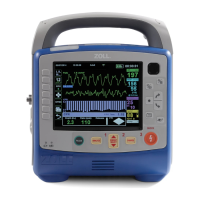Chapter 10 Pulse CO-Oximetry (SpO2)
10-4 www.zoll.com 9650-001355-01 Rev. M
• Inaccurate SpHb and SpOC readings may be caused by:
• Improper sensor application
• Intravascular dyes such as indocyanine green or methylene blue
• Externally applied coloring and texture such as nail polish, acrylic nails, glitter, etc.
• Elevated PaO2 levels
• Elevated levels of bilirubin
• Low arterial perfusion
• Motion artifact
• Low arterial oxygen saturation levels
• Elevated carboxyhemoglobin levels
• Elevated methemoglobin levels
• Hemoglobinopathies and synthesis disorders such as thalassemias, Hb s, Hb c, sickle
cell, etcetera
• Vasospastic disease such as Raynaud's
• Elevated altitude
• Peripheral vascular disease
• Liver disease
• EMI radiation interference
• Inaccurate SpO2 readings may be caused by:
• Improper sensor application.
• Elevated levels of COHb or MetHb: High levels of COHb or MetHb may occur with a
seemingly normal SpO2. When elevated levels of COHb or MetHb are suspected,
laboratory analysis (co-Oximetry) of a blood sample should be performed.
• Intravascular dyes, such as indocyanine green or methylene blue.
• Externally applied coloring and texture, such as nail polish, acrylic nails, glitter, etc.
• Elevated levels of bilirubin
• Severe anemia
• Low arterial perfusion
• Motion artifact
• Interfering Substances: Dyes or any substance containing dyes that change usual blood
pigmentation may cause erroneous readings.
• The pulse co-oximeter is intended only as an adjunct device in patient assessment. It should
not be used as the sole basis for diagnosis or therapy decisions. It must be used in
conjunction with clinical signs and symptoms.
• The pulse co-oximeter is not an apnea monitor.
• The pulse co-oximeter may be used during defibrillation, but this may affect the accuracy or
availability of the parameters and measurements.
• The pulse co-oximeter may be used during electrocautery, but this may affect the accuracy
or availability of the parameters and measurements.
• The pulse co-oximeter should not be used for arrhythmia analysis

